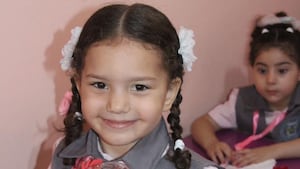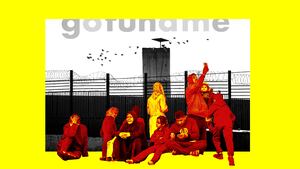The author of this story is anonymous for their safety.
RAFAH, the Gaza Strip—The vast majority of Gaza residents followed Israel’s instructions to flee their homes, which would supposedly keep them safe from the IDF’s war on Hamas. They took them at their word, taking flight with their extended families and a few belongings only to find that the bombs, death, and destruction would soon follow them.
As each alleged safe haven came under attack, the Israelis ordered families to move even further south. Hundreds of thousands of Palestinians obeyed those demands and are now huddled against the southern border with Egypt in the city of Rafah—some literally have their tents pitched against the fence that cages them inside a warzone.
How have they been rewarded?
The Israeli bombs have come to Rafah over the past week, and the rumors of an imminent invasion of the last refuge are now at fever pitch—powered by threats from Prime Minister Benjamin Netanyahu and Defense Minister Yoav Gallant. Deadly air strikes on Rafah Friday were accompanied by reports that another evacuation order would be issued before the tanks rolled in.
The United Nations called invasion plans a “disaster.” The European Union’s top diplomat said there would be “catastrophic consequences.”
“Where can we go if the Israeli army initiates an operation in Rafah?” asks Abu Zakaria al-Hams, 55.
He is living with six family members in a tent pitched right on the border with Egypt because of the overcrowding within Rafah city limits. This is not their first temporary home, after leaving their home in Gaza City, they sought refuge in Khan Yunis, which was a designated safe zone in the southern part of the Strip until Israel changed its mind and took their battle against Hamas to the city.
By U.N. Human Rights Office estimates over half of the entire population of the Gaza Strip—well over a million refugees—are now crammed into Rafah, a small city that was previously home to around 250,000 people.

An aerial view of the makeshift tents as the Palestinian families seek refuge at the El-Mavasi district as they struggle to find clean water, food and medicine as the Israeli attacks continue in Rafah on February 9, 2024.
Abed Zagout/Anadolu via Getty Images“There is no vacant space in Rafah to walk; the prices of food items have tripled, and they are not available at all times. My children haven’t had enough food for the past four months,” al-Hams said. “A day ago, the Israeli army suddenly targeted a kindergarten in Rafah, a civilian car and today a mosque. It is too risky to walk in the streets.”
An air strike on Rafah this month reportedly killed 16 members of a family who had already been forced to flee three times before settling in the final safe zone in the Strip.
Al-Hams wants to know where the IDF will order them next. “Will they permit our return to Gaza and the north, or will they compel us to cross the border?” he asked. Or perhaps, he fears, they will be given no evacuation corridor out and may have to flee for their lives themselves. “How can we cross this border? There are three types of fences and walls between Rafah and Sinai. It is impossible to survive.”
Like many who quit their homes believing Israeli claims that they would be safer in the supposed humanitarian zones in the south, al-Hams wishes he had ignored them.
“There’s no safe place, and I feel profound regret for leaving Gaza,” he said.
Four Homes in 100 Days
The refugees seeking shelter in Rafah have turned to improvised spaces, such as wedding halls and unfinished construction sites to keep them from the rainfall and winter nights. There are not enough tents to go around, leading many to resort to using plastic sheeting to make impromptu tents or to replace shattered windows or missing roofs.

Palestinians including children who fled from Israeli attacks and took refuge in Rafah city, try to survive in makeshift tents as they form a dense crowd on the streets of Rafah, Gaza on February 08, 2024.
Abed Rahim Khatib/Anadolu via Getty ImagesSamer Younis, 55, has set up a tent for his family in the middle of a street in Tal al-Sultan in Rafah where he is trying to make ends meet by selling crunchy handmade snacks to children. “I have no relatives in Rafah to stay in their house, and in order to shelter my family I had to construct a tent using nylon, the price of which has doubled,” he said. “There are hundreds of tents in this area now, it was empty a few weeks ago. The Israeli army squeezed us in Rafah which is too small compared to Khan Younis, where the operations of the army were increasing.”
The Younis family’s last three months desperately trying to survive with no fixed abode is typical.
As soon as the Oct. 7 massacre took place, they evacuated their home in eastern Gaza City, seeking refuge in the Shujiá neighborhood for a week. Following an Israeli army evacuation order on Oct. 13, Samer was forced to move again, settling in the Nuseirat refugee camp just south of the Gaza Valley.
“During about three months of staying in Nuseirat we suffered a water shortage, food prices rocketing up and other items that were barely available, especially bread and wheat. I lost 15 kg [over 30 lbs],” he said.
“The Israeli army had instructed us to go south of the Gaza Valley, but on Dec. 23, I was compelled to leave the Nuseirat refugee camp for Rafah as the Israeli army highlighted that our residential block was high-risk in the next phase of the war,” he said.
Samer’s anxiety intensified as the imminent birth of his grandchild approaches. Fearing the challenges of getting his daughter-in-law to the hospital this month, he strategically positioned his tent in close to the only accessible health-care facility in Rafah. Unfortunately, the area has many problems, including the absence of public transportation and the shutdown of mobile networks and internet services.
“We now find refuge in Tal al-Sultan, located to the west of Rafah, deemed a safe zone by the Israeli army. However, just a week ago, tragedy struck as the Israeli army targeted a nearby building, claiming lives within the Nofal family,” he said.
“The constant threat of displacement and evacuations haunts me, heightening concerns for the safety of my family. I worry that amidst these challenges, I may lose loved ones or witness my children sustaining injuries. The added distress lies in the uncertainty of being able to transport them to a hospital when needed."
“There is no anesthetic for surgery, and most medications are unavailable. Medicine is only provided to those close to Hamas employees, and this is a problem. Even the distribution mechanism of aid is unclear. No one provided us with even a can of food,” he said.
Samer’s wife, Maha, 45, said: “My dream now is a family gathering around a hot lunch or dinner, which is a luxury now. Or even to have a warm bath or even with cold water so children can sleep clean."
Sick Kids
Armed with a hammer and a small shovel, Mohammed al-Ghrabli is constructing a nylon tent that will serve as a temporary shelter for himself, his wife, and their three children. Having traveled to Rafah in the past week, he said, “This marks the fifth time we’ve faced displacement in the past three months.”
“We saw the death in Gaza when they shelled the residential quarters in our area last October. We were waiting to die. We woke everyday to live a new life,” he said.
“My children have many stomach and skin diseases and the UNRWA clinic doesn’t have the right medicine. We are taking a substitution. Even the food is unsafe,” he said.

Palestinian children walk among collapsed buildings as daily life continues under Israeli attacks in Rafah on February 05, 2024.
Abed Rahim Khatib/Anadolu via Getty ImagesAl-Ghrabli blamed both Hamas and Israel for the horrible situation that his family is facing as he says “With each evacuation order from the Israeli army we kept moving from Gaza to central Gaza to Khan Younis and now in Rafah. Hamas’ plan is unclear, are they proposing a solution for us? And will the Israeli army end this suffering soon?”
“We fear the Israeli army may instruct us to evacuate Rafah to Sinai or force us to cross the border into Sinai—it’s our worst nightmare, and thoughts of a bleaker future linger. We remain in anticipation, I am afraid we are not ready to face the uncertainty for what comes our way,” he said.
As rain is affecting the tents in the camp, he said: “The weather is bitterly cold, and we fled our house with summer clothes now it is winter and there are no clothes in the market. We use wood to make a fire at the door of the tent to get warmer.”
Mohammed Yasser, 53, leads a family of 17, including three grandchildren under 3. They moved to Rafah in December, but he does not see it as a beacon of safety. “You look at the people here, you feel they appear like zombies—exhausted, fatigued, thirsty, and unkempt,” he said.
“The biting cold within the tents has left our children’s skin cracked, blood flowing from their tiny lips. I’m not asking Arab or U.S. to help. I’m only asking Allah to grant us the reward for enduring these challenging days. Replace our sorrow with joy and relieve our constriction with a sense of comfort. In our desperate need, He is our only refuge.”








